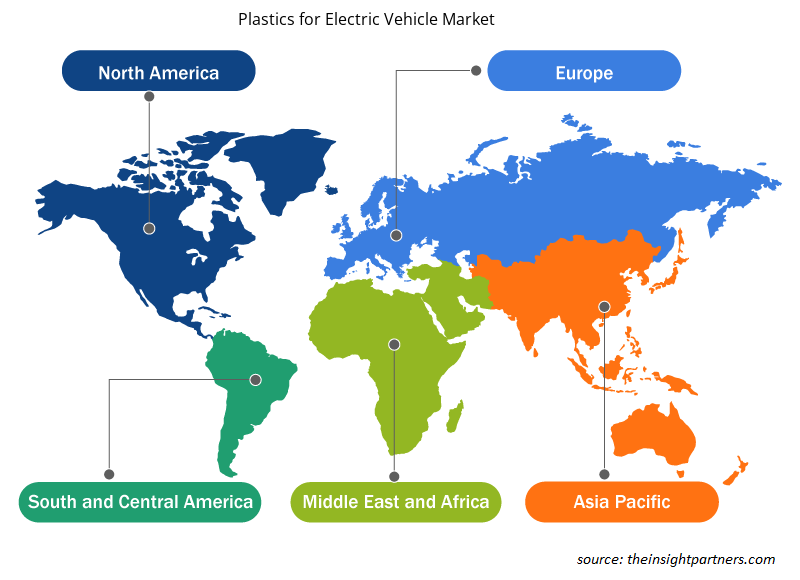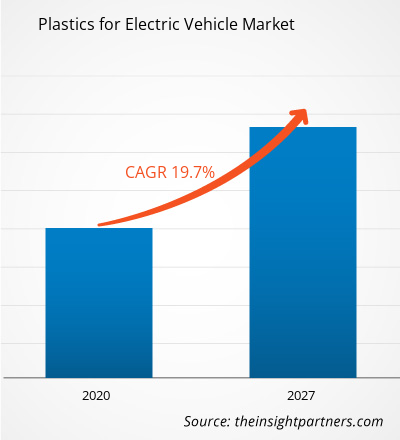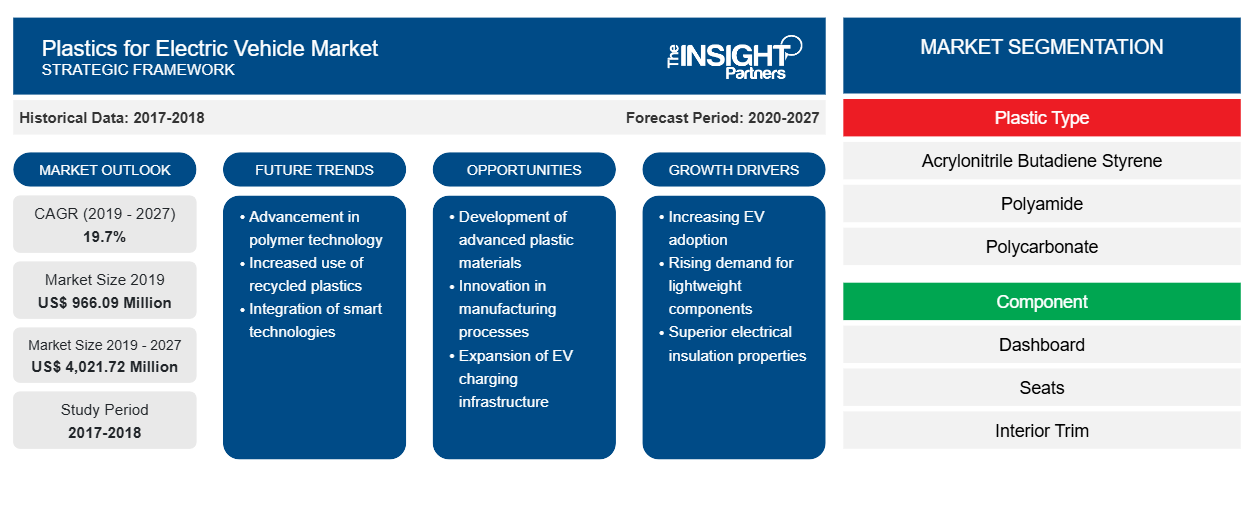Nel 2019, il mercato della plastica per veicoli elettrici era valutato 966,09 milioni di dollari USA e si prevede che raggiungerà i 4.021,72 milioni di dollari USA entro il 2027; si prevede una crescita a un CAGR del 19,7% dal 2020 al 2027.
La plastica può essere un conduttore elettrico e anche un isolante. Il polimero termoplastico può essere prodotto in varie forme e design in base alle esigenze dei veicoli elettrici grazie all'elevata versatilità e alla facile modellabilità della plastica. L'uso della plastica per i veicoli elettrici riduce il peso di questi veicoli, il che fornisce una maggiore autonomia tra le ricariche. La plastica offre un'eccellente resistenza al calore che consente la costruzione di vani batteria e sistemi di raffreddamento e non ostacola la durata e la sicurezza fornite dai veicoli elettrici. Si prevede che il mercato globale della plastica per veicoli elettrici in Nord America crescerà al CAGR più alto del 20,0% nel periodo 2020-2027.
La pandemia di COVID-19 è stata segnalata per la prima volta a Wuhan (Cina) nel dicembre 2019. A giugno 2020, Stati Uniti, Russia, India, Spagna, Brasile, Italia, Francia e Germania sono tra i paesi più colpiti in termini di casi positivi al COVID-19 e decessi segnalati. L'epidemia sta influenzando negativamente economie e industrie a causa di blocchi, divieti di viaggio e chiusure aziendali. I prodotti chimici e i materiali sono una delle principali industrie al mondo che sta subendo gravi interruzioni sotto forma di interruzioni della catena di fornitura, cancellazioni di eventi tecnologici e chiusure di uffici. La Cina è il polo manifatturiero globale e il più grande fornitore di materie prime per varie industrie in tutto il mondo, ed è anche uno dei paesi più colpiti dalla pandemia di COVID-19. Il blocco di vari impianti e fabbriche in Cina sta limitando le catene di fornitura globali e la produzione e la vendita di vari prodotti chimici e materiali. L'impatto complessivo della pandemia sta di conseguenza frenando la crescita del mercato della plastica per veicoli elettrici.
Personalizza questo report in base alle tue esigenze
Riceverai la personalizzazione gratuita di qualsiasi report, comprese parti di questo report, o analisi a livello nazionale, pacchetto dati Excel, oltre a usufruire di grandi offerte e sconti per start-up e università
- Scopri le principali tendenze di mercato in questo rapporto.Questo campione GRATUITO includerà analisi di dati che spaziano dalle tendenze di mercato alle stime e alle previsioni.
Approfondimenti di mercato
La crescente domanda di veicoli elettrici stimola la crescita del mercato
La produzione di automobili si sta spostando verso una minore generazione di emissioni di gas serra e verso un'efficienza nei consumi con la crescente enfasi sulla sostenibilità ambientale. Efficienza dei costi; sostenibilità ambientale; convenienza; adozione di tecnologie avanzate; e varie politiche governative come tariffe preferenziali, incentivi all'acquisto di attrezzature e sconti significativi sono tra i fattori che spingono la domanda di veicoli elettrici in tutto il mondo. Secondo l'IEA, è stato registrato un aumento del 40% anno su anno con le vendite di 2,1 milioni di auto elettriche a livello globale nel 2019, superando significativamente quello del 2018.
Approfondimenti sul tipo di plastica
In base al tipo di plastica, il mercato della plastica per veicoli elettrici è segmentato in acrilonitrile butadiene stirene (ABS), poliammide (PA), policarbonato (PC), polivinilbutirrale, poliuretano (PU), polipropilene (PP) e altri. Il segmento del polipropilene (PP) ha rappresentato la quota maggiore del mercato nel 2019. Il polipropilene (PP) si riferisce a un "polimero di addizione" termoplastico che viene prodotto combinando monomeri di propilene. È rigido e cristallino; pertanto, è ampiamente utilizzato per realizzare oggetti come vassoi di imballaggio, dispositivi medici e altri. Come una delle importanti famiglie di resine poliolefiniche, viene stampato ed estruso in qualsiasi tipo di plastica che richieda flessibilità, tenacità, leggerezza e resistenza al calore.
Informazioni sui componenti
In base al componente, il mercato della plastica per veicoli elettrici è segmentato in cruscotto, sedili, finiture interne, rivestimenti per auto, paraurti e altri. Il segmento delle finiture interne ha rappresentato la quota maggiore del mercato nel 2019. Le finiture interne in un veicolo elettrico si riferiscono ai componenti o pannelli in plastica presenti all'interno dell'abitacolo. Le finiture funzionali ed estetiche con caratteristiche gradevoli sono essenziali per fornire un'esperienza interna perfetta.
Informazioni sul tipo di veicolo
In base al tipo di veicolo, il mercato della plastica per veicoli elettrici è diviso in BEV e PHEV/HEV. Il segmento BEV ha rappresentato la quota maggiore del mercato nel 2019. I veicoli elettrici a batteria o BEV immagazzinano elettricità a bordo con pacchi di batterie ad alta capacità. L'energia nella batteria viene utilizzata per far funzionare il motore elettrico e altri dispositivi elettronici a bordo. Le materie plastiche vengono utilizzate nella realizzazione di connettori e alloggiamenti per i componenti elettrici richiesti nei veicoli elettrici.
Approfondimenti sulle applicazioni
In base all'applicazione, il mercato della plastica per veicoli elettrici è ulteriormente segmentato in sistema di trasmissione/sotto cofano, esterno, interno e illuminazione e cablaggio elettrico. Il segmento interno ha rappresentato la quota maggiore del mercato nel 2019. Le plastiche ad alte prestazioni sono utilizzate nei veicoli elettrici per garantire sicurezza e protezione. Il polipropilene è frequentemente utilizzato nelle parti delle auto come taniche di benzina e fibre di moquette del pavimento interno. Il PVC è utilizzato nei serbatoi e nei cruscotti delle auto grazie alla sua finitura elegante. Volanti e cruscotti sono anche prodotti con acrilonitrile butadiene stirene o plastica ABS. L'ampia applicazione delle plastiche nei volanti, nei pavimenti interni e nelle console favorisce la crescita del mercato delle plastiche per veicoli elettrici per il segmento delle finiture interne.
Approfondimenti regionali sul mercato delle materie plastiche per veicoli elettrici
Le tendenze regionali e i fattori che influenzano il mercato delle materie plastiche per veicoli elettrici durante il periodo di previsione sono stati ampiamente spiegati dagli analisti di Insight Partners. Questa sezione discute anche i segmenti e la geografia del mercato delle materie plastiche per veicoli elettrici in Nord America, Europa, Asia Pacifico, Medio Oriente e Africa e America meridionale e centrale.

- Ottieni i dati specifici regionali per il mercato delle materie plastiche per veicoli elettrici
Ambito del rapporto di mercato sulla plastica per veicoli elettrici
| Attributo del report | Dettagli |
|---|---|
| Dimensioni del mercato nel 2019 | 966,09 milioni di dollari USA |
| Dimensioni del mercato entro il 2027 | 4.021,72 milioni di dollari USA |
| CAGR globale (2019 - 2027) | 19,7% |
| Dati storici | 2017-2018 |
| Periodo di previsione | 2020-2027 |
| Segmenti coperti | Per tipo di plastica
|
| Regioni e Paesi coperti | America del Nord
|
| Leader di mercato e profili aziendali chiave |
|
Densità degli attori del mercato delle materie plastiche per veicoli elettrici: comprendere il suo impatto sulle dinamiche aziendali
Il mercato delle materie plastiche per veicoli elettrici sta crescendo rapidamente, spinto dalla crescente domanda degli utenti finali dovuta a fattori quali l'evoluzione delle preferenze dei consumatori, i progressi tecnologici e una maggiore consapevolezza dei vantaggi del prodotto. Con l'aumento della domanda, le aziende stanno ampliando le loro offerte, innovando per soddisfare le esigenze dei consumatori e capitalizzando sulle tendenze emergenti, il che alimenta ulteriormente la crescita del mercato.
La densità degli operatori di mercato si riferisce alla distribuzione di aziende o società che operano in un particolare mercato o settore. Indica quanti concorrenti (operatori di mercato) sono presenti in un dato spazio di mercato in relazione alle sue dimensioni o al valore di mercato totale.
Le principali aziende che operano nel mercato delle materie plastiche per veicoli elettrici sono:
- BASF SE
- Società Solvay SA
- DuPont de Nemours, Inc.
- La società chimica Dow
- LG Chem Ltd
Disclaimer : le aziende elencate sopra non sono classificate secondo un ordine particolare.

- Ottieni una panoramica dei principali attori del mercato delle materie plastiche per veicoli elettrici
Segnala i riflettori
- Tendenze industriali progressive nel mercato globale della plastica per veicoli elettrici che aiutano gli operatori a sviluppare strategie efficaci a lungo termine
- Strategie di crescita aziendale adottate dai mercati sviluppati e in via di sviluppo
- Analisi quantitativa del mercato della plastica per veicoli elettrici dal 2017 al 2027
- Stima della domanda di plastica per veicoli elettrici in vari settori a livello globale
- Analisi PEST per illustrare l'efficacia degli acquirenti e dei fornitori che operano nel mercato
- Sviluppi recenti per comprendere lo scenario competitivo del mercato e la domanda di plastica per veicoli elettrici
- Tendenze e prospettive del mercato e fattori che guidano e frenano la crescita del mercato
- Comprensione delle strategie che sostengono la crescita del mercato globale della plastica per veicoli elettrici, che aiuta le parti interessate nel processo decisionale
- Dimensioni del mercato della plastica per veicoli elettrici in vari nodi del mercato
- Panoramica dettagliata e segmentazione del mercato e dinamiche del settore
- Dimensioni del mercato globale della plastica per veicoli elettrici in varie regioni con promettenti opportunità di crescita in queste regioni
Plastica per il mercato dei veicoli elettrici, per tipo di plastica
- Acrilonitrile Butadiene Stirene
- Poliammide
- Policarbonato
- Polivinilbutirrale
- Poliuretano
- Polipropilene
- Altri
Plastica per il mercato dei veicoli elettrici, per componente
- Pannello di controllo
- Posti a sedere
- Rifiniture interne
- Rivestimenti per auto
- Paraurti
- Altri
Plastica per il mercato dei veicoli elettrici, per tipo di veicolo
- Veicolo elettrico
- Veicolo elettrico ibrido/ibrido
Plastica per il mercato dei veicoli elettrici, per applicazione
- Sistema di trasmissione/Sotto il cofano
- Esterno
- Interno
- Illuminazione e cablaggio elettrico
Profili aziendali
- BASF SE
- Società Solvay SA
- DuPont de Nemours, Inc.
- La società chimica Dow
- Azienda LG Chem Ltd.
- Lanxess AG
- Sabico
- Covestro AG
- Società Asahi Kasei
- Società per azioni Lyondellbasell Industries Holdings BV
- Analisi storica (2 anni), anno base, previsione (7 anni) con CAGR
- Analisi PEST e SWOT
- Valore/volume delle dimensioni del mercato - Globale, Regionale, Nazionale
- Industria e panorama competitivo
- Set di dati Excel
Report recenti
Rapporti correlati
Testimonianze
Motivo dell'acquisto
- Processo decisionale informato
- Comprensione delle dinamiche di mercato
- Analisi competitiva
- Analisi dei clienti
- Previsioni di mercato
- Mitigazione del rischio
- Pianificazione strategica
- Giustificazione degli investimenti
- Identificazione dei mercati emergenti
- Miglioramento delle strategie di marketing
- Aumento dell'efficienza operativa
- Allineamento alle tendenze normative





















 Ottieni un campione gratuito per - Plastica per il mercato dei veicoli elettrici
Ottieni un campione gratuito per - Plastica per il mercato dei veicoli elettrici